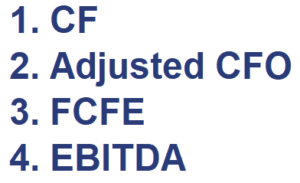Alternative Definitions of Cash Flow
There are at least four net income plus non-cash charges used in price and enterprise value (EV) multiples. Each of these cash flow definitions has its limitations. On this page, we discuss the following four alternative definitions of cash flow:
- earnings-plus-non cash charges (CF)
- adjusted cash flow (adjusted CFO)
- free cash flow to equity (FCFE)
- earnings before interest, taxes, depreciation, and amortization (EBITDA)
We also discuss how cash flow is used by analysts to calculate the price to cash-flow ratio.
Earnings-plus-non cash charges (CF)
One commonly used proxy for cash flow is earnings-plus-noncash charges (CF), which is calculated as follows:
The limitation of this definition is that it ignores some items that affect cash flow, such as non-cash revenue and changes in net working capital.
Cash flow from operations (CFO)
Another proxy for cash flow is cash flow from operations (CFO) from the cash flow statement. CFO is often adjusted for nonrecurring cash flows.
US GAAP requires interest paid, interest received, and dividends received to be classified as operating cash flows. IFRS, however, is more flexible: interest paid may be classified as either an operating or financing cash flow, while interest and dividends received can be classified as either operating or investing cash flows. Thus, care should be taken when comparing firms reporting under different standards.
Free cash flow to equity
Analysts also often use free cash flow to equity (FCFE) and earnings before interest, taxes, depreciation, and amortization as proxies for cash flow. FCFE is theoretically more appropriate, but it is also more volatile than straight cash flow:
where FCInv is fixed capital investment and net borrowing is debt issues – debt repayments.
EBITDA
Finally, EBITDA is a pretax, pre-interest measure that represents a flow to both equity and debt. Thus it is better suited as an indicator of total company value than just equity value.
Price to cash flow ratio
Whatever the definition used for cash flow, analysts will typically use the trailing price to cash flow ratio, which relies on the most recent four quarters of cash flow per share. The P/CF is calculated as follows:
Summary
We discussed four alternative definitions of cash flow that can be used to calculate the price to cash flow ratio.

